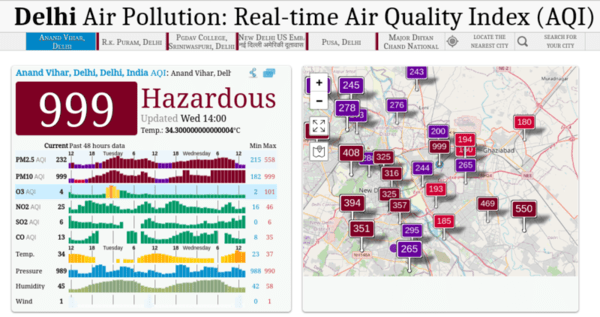
Winter Break Advanced in Delhi Schools Due to Pollution

Delhi Air Pollution: The Real-time Air Quality Index (AQI) on November 8, 2023 shows hazardous air quality level in Delhi.
Winter Break Advanced in Delhi Schools Due to Pollution
With increasing pollution, the people of Delhi – including children – are inhaling poison from the air.
While pollution – as usual – is increasing in New Delhi, the local government has decided to advance the winter break in schools so that students and teachers could stay at home.
As a result, the Delhi schools will remain closed from November 9 to 18, although the usual winter break is observed in the month of December.
While the air quality remains bad throughout the year in Delhi, the pollution levels cross hazardous limits in the winter months of November, December, and January.
The real-time data shows that the Air Quality Index (AQI) today (November 8, 2023) was in the “hazardous” category in almost all parts of Delhi, while it has become difficult for people to even breathe properly. The air quality is expected to deteriorate in the coming days and weeks.
In fact, the AQI in Delhi remains at hazardous or unhealthy levels throughout the year. But the government and pollution-control agencies do not take any steps to combat pollution.
Although the government does not release data related to pollution-related diseases and deaths in Delhi, it is estimated that besides killing nearly 5,000 people every month, pollution is causing multiple diseases among thousands of people in the city.
According to the World Health Organization or WHO, in adults, ischaemic heart disease and stroke are the most common causes of premature death attributable to outdoor air pollution, and evidence is also emerging of other effects such as diabetes and neurodegenerative conditions. In children, this could include reduced lung growth and function, respiratory infections, and aggravated asthma.
A Swiss-based international air quality technology company IQAir offers the IQAir platform to measure ground-level particulate matter (PM2.5) in real time. This data is then combined with a city’s population, health data, and scientific risk models to determine mortality and cost estimates.
PM2.5 is particulate matter pollution measuring 2.5 microns or less. These microscopic particles are considered a major threat to human health. PM2.5 can be inhaled and absorbed into the bloodstream, impacting both the respiratory and cardiovascular system.
An interactive tool on the Breathe Life 2030 website shows a particulate matter (PM 2.5) level of 105 micrograms per cubic metre (annual mean) in Delhi. This is 21 times more than the WHO safe level of 5 µg/m3.
Simply put, the people of Delhi – including children – are inhaling poison from the air.


